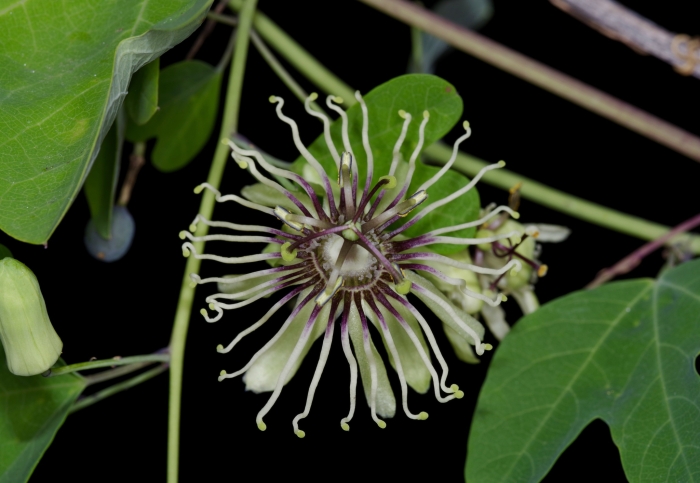Texas Passionflower
(Passiflora affinis)
Texas Passionflower (Passiflora affinis)
/
/

Michelle W.
CC BY 4.0
Image By:
Michelle W.
Recorded By:
Copyright:
CC BY 4.0
Copyright Notice:
Photo by: Michelle W. | License Type: CC BY 4.0 | License URL: http://creativecommons.org/licenses/by/4.0/ | Rights Holder: Michelle W. | Publisher: iNaturalist | Date Created: 2020-09-29T21:19:33-07:00 |

























Estimated Native Range
Summary
Passiflora affinis, commonly known as Texas passionflower, is a climbing vine native to open woodlands, grasslands, and roadsides in Texas and parts of Mexico. It can reach lengths of up to 6 meters and is characterized by its twining tendrils and deep green, three-lobed leaves. The Texas passionflower produces intricate, dark purple to nearly black flowers about 2-3 inches in diameter from mid-summer to early fall. The flowers are highly showy with a unique structure that includes a ring of filaments surrounding the central reproductive parts, making them attractive to pollinators and gardeners alike.
Texas passionflower is valued for its striking flowers and its role as a host plant for butterfly larvae, including the Gulf Fritillary. It is often used in butterfly gardens, on trellises, and as a naturalizing element in informal garden settings. This vine thrives in full sun to partial shade and prefers well-drained soil, although it is tolerant of a range of soil types. It has moderate water requirements and can be drought-tolerant once established. While generally low-maintenance, it can become invasive if not managed properly, spreading through root suckers and seed dispersal. Gardeners should be aware of its potential to overtake nearby plantings.CC BY-SA 4.0
Texas passionflower is valued for its striking flowers and its role as a host plant for butterfly larvae, including the Gulf Fritillary. It is often used in butterfly gardens, on trellises, and as a naturalizing element in informal garden settings. This vine thrives in full sun to partial shade and prefers well-drained soil, although it is tolerant of a range of soil types. It has moderate water requirements and can be drought-tolerant once established. While generally low-maintenance, it can become invasive if not managed properly, spreading through root suckers and seed dispersal. Gardeners should be aware of its potential to overtake nearby plantings.CC BY-SA 4.0
Plant Description
- Plant Type: Herb, Vine
- Height: 1-2 feet
- Width: 3-6 feet
- Growth Rate: Rapid
- Flower Color: Cream, Green
- Flowering Season: Spring, Summer, Fall
- Leaf Retention: Deciduous
Growth Requirements
- Sun: Full Sun, Part Shade
- Water: Low
- Drainage: Medium, Fast
Common Uses
Bee Garden, Butterfly Garden, Drought Tolerant, Showy Flowers
Natural Habitat
Native to open woodlands, grasslands, and roadsides in Texas and parts of Mexico
Other Names
Common Names: Wild Passion Vine, Texas Passionflower
Scientific Names: , Passiflora affinis,
GBIF Accepted Name: